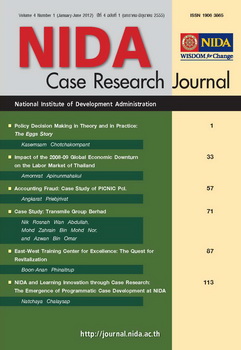NIDA and Learning Innovation through Case Research: The Emergence of Programmatic Case Development at NIDA
Keywords:
Learning Innovation, Case Study/Research, Participation, Change Theory, Risk Management, Academic Freedom, MotivationAbstract
Back to his office after discussing informally with Dr. Pradit Wannarat, Vice President of Academic Affairs, about the recently launched case study development project that afternoon after the luncheon following the July 2011 monthly meeting of deans and directors of schools and centers, President of National Institute of Development Administration (NIDA) Sombat Thamrongthanyawong felt deeply concerned about the project survival. The project would surely end if no other actions were taken.
The case research and writing project was part of his proposal when Professor Dr. Sombat ran for office of NIDA presidency. When he became president of NIDA he launched it in 2007 immediately after he made a decision to urge all NIDA faculty to use case studies as instructional material. So far, NIDA had invested a large amount of money to materialize the case research and writing project. Four workshops were arranged – the first three of which were conducted by an external facilitator (a veteran case researcher and writer from the Harvard Business School, who had received awards in casewriting), and the fourth of which was facilitated by a group of NIDA faculty who had succeeded in writing two cases since the outset of the NIDA case development project. Following each of the first three workshops, faculty were encouraged to propose case frames for the review, approval, and recommendations of the external facilitator. If the case frames were approved, the authors would then proceed to complete and submit them (via email), along with the teaching note, to the external facilitator for a thorough review, critique, feedback, and often re-crafting. A case practicum followed each workshop. Apart from establishing the NIDA Case Research Journal to publish the cases, an academic seminar was arranged after the practicum as another channel to publicize the cases.
Some faculty proposed case frames but did not complete them. Out of around 130 faculty attending the workshops, only 21 case studies were generated and published, of which nearly half (i.e., 10) had been developed by the 6 case writers who were repeat authors. Many faculty gave a reason for failure to write a case that they had to fulfill required workloads and had no extra time for generating case studies. Others said that they had to finish other tasks sponsored by the NIDA Research Center first. Still, others said that the type of case studies solicited by the external facilitator was not similar to cases in their fields. Whatever reason the faculty gave, it reflected their disinterest in writing case studies as instructional material, although Dr. Sombat used quite a handsome sum of 200,000 baht as an incentive for case research and writing.
Moreover, Dr. Sombat tried to be flexible about the workload by allowing a research study or a textbook to be replaced with a case study; still, few faculty were interested to write a case on the ground that it could not be used to replace a research study or a textbook to obtain a higher academic rank. Although he talked to the authority in the Ministry of Education about this issue, no satisfactory answer came from those with authoritative power.
Another concern was that NIDA Case Research Journal would soon encounter an inadequate number of cases for publishing. It was also considered as only a local journal, not even a national journal. One outlet decided by the case writing committee was to hold an international conference on case studies on September 8-9, 2011 so that more cases would be submitted from faculty in other Thai universities and those from overseas universities. They could then be selected to publish in the journal in order to upgrade it to an international journal in the future. In spite of a good response from overseas faculty, Dr. Sombat wanted NIDA faculty to produce case studies in Thai contexts for classroom use to fulfill his vision of NIDA becoming a world class university. He also wanted the journal to primarily accommodate NIDA faculty’s cases. Until now (July 2011) he could not satisfactorily accomplish this.
Dr. Sombat invested a huge amount of money in the case research and writing project and the problem of faculty participation emerged. He indirectly exercised his power to coerce NIDA faculty to attend case research and writing workshops and was successful to a certain extent for that purpose. However, he was not quite successful in urging them to research and write cases for several factors as mentioned above. Now, it was time to appraise the project. He began to ask himself, “Is the long-run survival of the case research and writing project possible? What strategies should he use to gain faculty participation?





